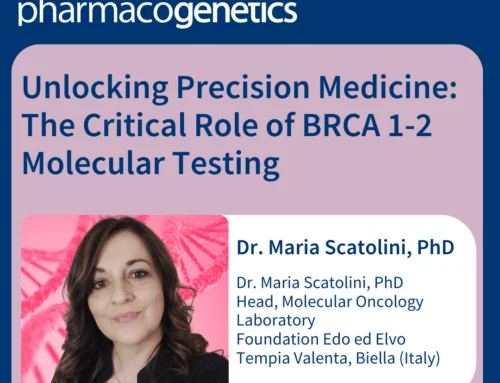Drug response is highly variable between individuals. This interindividual variability response to medication, which contributes to adverse drug reactions (ADRs), is mainly due to interaction between genetic variants and medications (1).
ADRs are estimated to be between the fourth and sixth most common cause of death worldwide, entering in the list of other prevalent causes of mortality such as heart disease, cancer, and stroke. ADRs impact on a broad range of populations worldwide, with significant mortality and morbidity burden in vulnerable groups, such as older people, pediatric populations, and individuals in low-income (2). ADR-related healthcare costs are significant: for example, in the United States and Europe, the financial burden is estimated annually from approximately $30–135 billion US dollars and €79 billion euros, respectively, clearly indicating the need for improvement (2,3).
Considering that over 95% of individuals carry at least one genetic variant that can potentially lead to an atypical drug response, and with drugs impacted by these genetic variants being in common use (4), pharmacovigilance activities aimed at detecting and preventing ADRs can potentially save healthcare systems significant amounts of money.
To guide health-care providers with the application of PGx in clinical practice, internationally recognized PGx consortia guidelines, such as those produced by the Clinical Pharmacogenetics Implementation Consortium (CPIC) or by the Dutch Pharmacogenetics Working Group (DPWG), provide clinically actionable guidance for a subset of drugs with well validated drug–gene relationships (5,6).
PGx testing for single drug-gene pairs either following ADRs (reactive) or a first prescription (pretherapeutic) have been introduced in clinical practice about twenty years ago. In general, these drug-gene pairs are supported by a high level of clinical evidence and currently, this type of single drug-gene testing remains the most frequently applied example of PGx testing in clinical practice. Among these PGx tests, pretherapeutic single-gene PGx test for DPYD and fluoropyrimidines, for CYP2C19s and clopidogrel or for UGT1A1 and irinotecan are representative examples (4).in a recent study, it has been reported that pretreatment DPYD testing led to reductions in toxicity, hospitalization, and treatment delay, with clear implications on quality of life and health care costs (7).
Due to the demonstrated efficacy of single drug-gene testing in clinical practice, the feasibility to introduce a panel-based approach was evaluated. The rational to introduce PGx panel tests in clinical practice lies on two reasons:
- the first is the very high percentage of patients carrying at least one actionable PGx variant (4)
- the second is the common use of the drugs included in the CPIC and DPWG guidelines (5,6).
A typical example is warfarin, a widely used anticoagulant in the treatment and prevention of thrombosis, for the treatment of chronic atrial fibrillation, mechanical valves, pulmonary embolism, and dilated cardiomyopathy. The main adverse reaction to warfarin is hemorrhage. Studies demonstrated that warfarin, along with other anti-hemorrhagic drugs, accounted for 60% of death cases among patients hospitalized due to ADRs. Therefore, CYP2C9 and VKORC1 polymorphisms testing is recommended for differential warfarin response and for setting the correct dosing and is crucial to reduce adverse clinical events, thus underlining the usefulness of a panel gene testing (8).
Two prospective clinical studies were designed to investigate the clinical utility of preemptive PGx panel testing. Patients enrolled in two studies were affected by broad range of diseases and treated with different drugs for which PGx recommendations were available from CPIC or the DPWG guidelines. In both studies, the occurrence of ADRs was used as a primary end point.
- The Preemptive Pharmacogenomic Testing for Prevention of Adverse Drug Reactions (PREPARE) study (NCT03093818) was an open-label, multicenter, controlled, cluster-randomized, crossover implementation study involving a 12-gene PGx panel according to the DPWG recommendations. The primary outcome was to analyze the incidence of clinically relevant, patient-reported ADRs within the 12-week follow-up period (10).
- The Indiana Genomics Implementation: An Opportunity for the Underserved (INGENIOUS) trial (NCT02297126) was conducted by the Implementing Genomics in Practice (IGNITE) network. This was a pragmatic prospective randomized controlled trial designed to assess the impact of prospective PGx on health-care costs for 1-year follow-up. The PGx panel test consisted of 43 SNVs in 13 genes) based on recommendations provided by CPIC and DPWG (5,6). The main outcome was the occurrence of ADRs during the follow-up period of 1 year. (11)
Both studies indicate a favorable effect of pretherapeutic PGx panel testing, supporting the clinical implementation of pretherapeutic PGx panel testing for patients receiving a first prescription for a drug with an actionable recommendation in the CPIC and/or DPWG guidelines. Indeed, both studies reported a 30% reduction of clinically relevant adverse drug reactions and this result is achieved by using standardized pharmacogenetic tests that support pharmacogenetics-guided decision.
In conclusion, the available evidences support implementation of pretherapeutic PGx panel testing for drugs covered in the PGx guidelines, promising potential for predicting and preventing ADRs, thus reducing healthcare resource utilization and improving long-term patient care.
References
- Mini E, Nobili S. Pharmacogenetics: implementing personalized medicine. Clin Cases Miner Bone Metab. 2009 Jan;6(1):17-24.
- Le Louët H, Pitts PJ. Twenty-First Century Global ADR Management: A Need for Clarification, Redesign, and Coordinated Action. Ther Innov Regul Sci. 2023 Jan;57(1):100-103
- Pirmohamed, M. Pharmacogenomics: current status and future perspectives. Nat Rev Genet24, 350–362 (2023). https://doi.org/10.1038/s41576-022-00572-8
- McInnes G, Lavertu A, Sangkuhl K, Klein TE, Whirl-Carrillo M, Altman RB. Pharmacogenetics at Scale: An Analysis of the UK Biobank. Clin Pharmacol Ther. 2021 Jun;109(6):1528-1537.
- Relling MV, Klein TE. CPIC: Clinical Pharmacogenetics Implementation Consortium of the Pharmacogenomics Research Network. Clin Pharmacol Ther. 2011 Mar;89(3):464-7.
- Dutch Pharmacogenetic Working Group of the Royal Dutch Pharmacists Association. [cited 13 Aug 2020]. Available from: https://www.knmp.nl/dossiers/farmacogenetica
- Nguyen DG, Morris SA, Hamilton A, et al. Real-World Impact of an In-House Dihydropyrimidine Dehydrogenase (DPYD) Genotype Test on Fluoropyrimidine Dosing, Toxicities, and Hospitalizations at a Multisite Cancer Center. JCO Precis Oncol. 2024 Jun;8
- Cross B, Turner RM, Zhang JE, Pirmohamed M. Being precise with anticoagulation to reduce adverse drug reactions: are we there yet? Pharmacogenomics J. 2024 Mar 5;24(2):7.
- Mosch R, van der Lee M, Guchelaar HJ, Swen JJ. Pharmacogenetic Panel Testing: A Review of Current Practice and Potential for Clinical Implementation. Annu Rev Pharmacol Toxicol. 2025 Jan;65(1):91-109.
- Swen JJ, van der Wouden CH, Manson LE, Abdullah-Koolmees H et al. A 12-gene pharmacogenetic panel to prevent adverse drug reactions: an open-label, multicentre, controlled, cluster-randomised crossover implementation study. Lancet. 2023 Feb 4;401(10374):347-356.
- Eadon MT, Rosenman MB, Zhang P, et al. The INGENIOUS trial: Impact of pharmacogenetic testing on adverse events in a pragmatic clinical trial. Pharmacogenomics J. 2023 Nov;23(6):169-177.
- Chenchula S, Atal S, Uppugunduri CRS. A review of real-world evidence on preemptive pharmacogenomic testing for preventing adverse drug reactions: a reality for future health care. Pharmacogenomics J. 2024 Mar 15;24(2):9.





